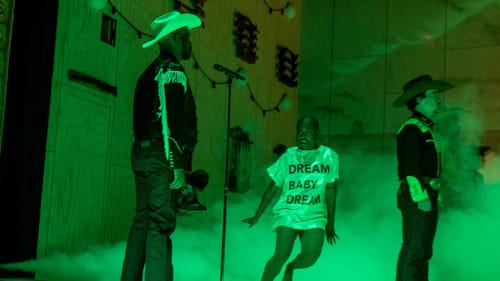Stay in the Loop
BSR publishes on a weekly schedule, with an email newsletter every Wednesday and Thursday morning. There’s no paywall, and subscribing is always free.
A whole new darkness
The Kimmel Cultural Campus presents Rodgers & Hammerstein’s Oklahoma!

O-K-L-A-H-O-M-A, Oklahoma! That’s the rousing anthem from this mid-20th-century American musical, the number everyone is waiting for, which the cast belts out as the audience traditionally claps along. The song is still there in its 11th-hour spot, but in the reimagined version of the national tour now at the Forrest Theatre, that’s about the only thing that's traditional.
While he took a fresh look at this iconic show, in the interest of reinvention, director Daniel Fish also jettisoned much of its lyricism for an edgy, purposefully ragged staging. He vividly and boldly explores what’s darker in the story. And as it undoubtedly paints a truer portrait of our national psyche and deeply flawed westward expansion, the show is often jarring and unsettling.
Daring us what to feel
The original production of Oklahoma! opened in 1943 and played on Broadway for more than five years. Based on Lynn Riggs’s WPA-era play Green Grow the Lilacs (itself with a brief 1931 Broadway run), it was the first collaboration of Richard Rodgers and Oscar Hammerstein II. Legendary filmmaker and theater director Rouben Mamoulian staged the production, and the choreographer was the legendary Agnes de Mille, who put a ballet smack in the middle of it.
The show has always had the (annoying? uplifting?) exclamation point in its title, almost daring the theatergoer what to feel.
Fish boldly took up that dare. It’s been only four years (but long ones) since this controversial retelling leaped with temerity from the small stage onto Broadway. In 2019, it won the Tony award for best revival, and the director’s inventive vision got an enthusiastic New York reception.
de Mille and Heginbotham, Rodgers and Kluger
From the beginning, the show (now titled Rodgers & Hammerstein’s Oklahoma!) has advertised that Fish has left the original book and music intact, and there’s no reason to doubt it, especially given its almost-three-hour run time. There’s still a “dream dance” Act II opener, here a frenetic turn (performed passionately by Gabrielle Hamilton) in which John Heginbotham has swapped his muscular (sometimes repetitive) choreography for ballet.
Movement-wise, the first act is remarkably static, though some second-act hoedown-style dancing bows to de Mille. Laura Jellinek’s sparse, plywood setting foregrounds a Grant-Wood-like scene that seems to be a painted backdrop, but it’s actually a projection with almost imperceptible movement that adds to the unease and uncertainty. Scott Zielinski’s lighting design boldly follows Fish’s visceral bite—sometimes it is glaringly bright, while some scenes are played in total darkness, leaving the viewer to wonder what the actors are doing.

The cast is peopled with both Broadway powerhouse actors and rising stars. Dressed by Terese Wadden in boots and contemporary western garb, they include Barbara Walsh (Aunt Eller), Sasha Hutchings (Laurey), Sean Grandillo (Curley), Christopher Bannow (Jud), Hennessy Winkler (Will), and Sis (Ado Annie)—theater pros one and all who bring commitment, grit, and freshness (though unfortunately, not always top-flight singing) to these iconic roles. The music (re-orchestrated and arranged by Daniel Kluger for a seven-piece bluegrass band) is conducted by percussionist Andy Collopy (also on accordion); and the banjo’s pizzicato, along with the whine of the pedal-steel, are often surprisingly in tune with Rodgers’s music.
True to the tagline
In New York, the show was performed in the round at Circle in the Square, the audience engaged in its folksy, corn-shucking stage business. Fish completely restaged it for tour proscenium houses (like the Forrest) that were the mid-20th-century norm when it was written. It’s also been the norm to gloss over the show’s deeply dark elements and focus on its prairie sweep and musical beauty, things Fish entirely eschews.
Rodgers and Hammerstein crafted Oklahoma! to have a compelling, strange, knife-edge balance. For instance, the beautiful ballad “People Will Say We’re in Love” is almost directly followed by the bleakness of “Pore Jud is Daid,” and the show ends not with a wedding but a murder trial. But its precarious delicacy has been subsumed in this production.
There have been recent re-stagings of classic musicals (Lincoln Center’s South Pacific and My Fair Lady come to mind) that look anew while making obeisance to their origin. But this is not one of them. Under Fish’s heavy hand, the stage is festooned with racks of guns (blanks are fired during the show) and darkness overcomes. Even the wedding (replete with confectionary bridal dress) ends up bathed in Grand-Guignol blood.
Though you may feel the loss of the show’s historicity, Fish’s production does have many arresting and heart-stopping moments. There is also a wonderfully balanced and diverse cast aptly reflecting present-day America. It would likely prove illuminating to see this production again, allowing the novelty to recede and Fish’s vision to come more cleanly forward. But there’s no denying, as its publicity materials trumpet, “This is Oklahoma! like you’ve never seen it before.”
What, When, Where
Rodgers & Hammerstein’s Oklahoma! Music by Richard Rodgers, book and lyrics by Oscar Hammerstein II; directed by Daniel Fish, choreography by John Heginbotham; orchestration, arrangements, and musical supervision by Daniel Kluger. $47-$197. Through March 20, 2022, at the Kimmel Cultural Campus’s Forrest Theatre, 1114 Walnut Street, Philadelphia. (215) 893-1999 or kimmelculturalcampus.org.
Forrest Theatre requires all guests five years of age or older to show proof of full Covid-19 vaccination for entry. Adults 18+ required to show photo identification with vaccination proof.
Accessibility
The Forrest has wheelchair seating available, as well as seating locations near the stage for patrons with low vision or blindness. There will be an ASL-interpreted and audio-described performance of Oklahoma! on Friday, March 11, at 8pm.
Sign up for our newsletter
All of the week's new articles, all in one place. Sign up for the free weekly BSR newsletters, and don't miss a conversation.

 Gail Obenreder
Gail Obenreder